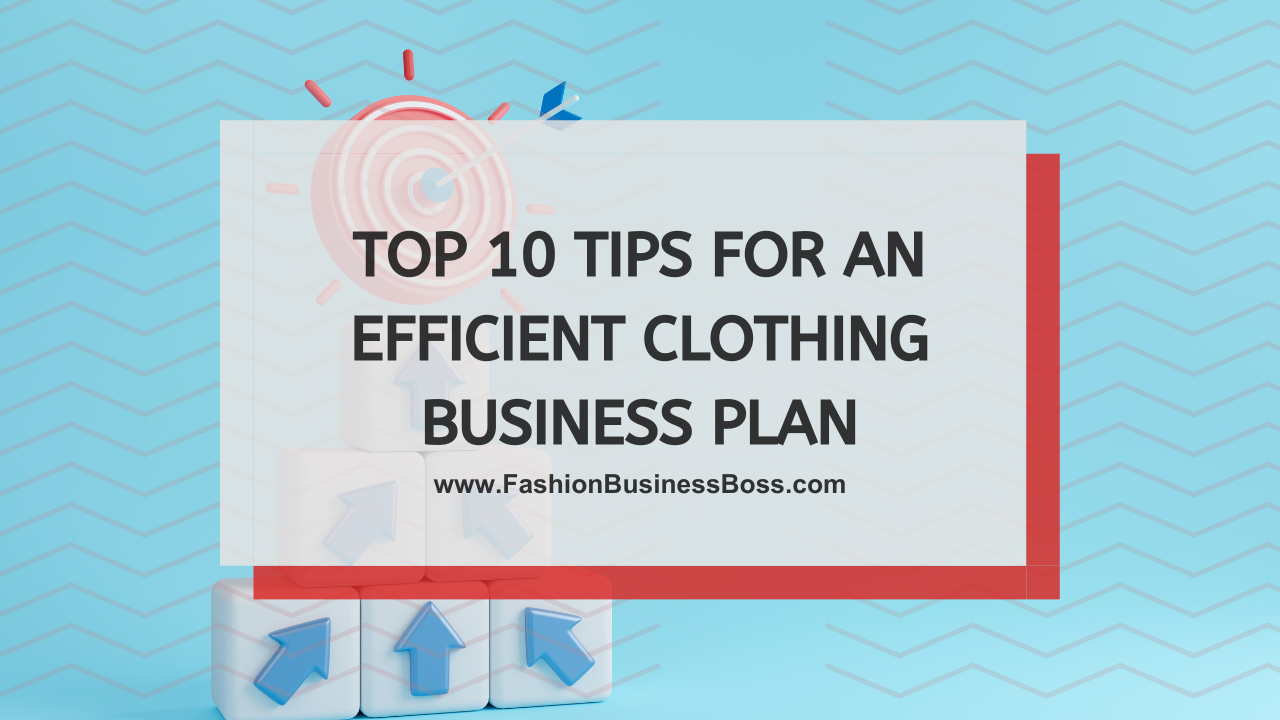Starting a clothing business can be an exciting venture, but it requires careful planning and strategic thinking to ensure its growth. A well-thought-out business plan lays the foundation for your clothing business, helping you navigate challenges and seize opportunities.
To excel in the fashion industry, grasp your market, craft a unique brand, analyze competitors, and create a standout product line. Develop a strategic marketing plan, efficient production, and monitor trends for adaptive growth.
In this article, we’ll provide you with the top 10 tips for creating an efficient clothing business plan that sets you up for triumph in the competitive world of fashion.
Understanding the Market and Audience

In the world of clothing businesses, grasping the market and your potential customers is like laying the foundation of your enterprise. It’s about knowing what people like, what’s trendy, and where there are gaps to fill. By understanding these aspects, you’ll be better equipped to make smart decisions.
When you dig deep into the market, you can pinpoint the subtle shifts that can shape your brand. It’s not just about knowing; it’s about using that knowledge to offer something unique. This approach helps you become a solution provider rather than just another player in the field.
Moreover, it’s essential to know your audience inside out. By doing so, you can create products that cater directly to their needs and preferences. This customer-centric approach sets you apart from the competition and attracts loyal customers.
So, in your clothing business plan, make sure to emphasize understanding the market and audience. It’s the first step in building a solid foundation for your venture.
Read more about: From Vision to Victory: The Blueprint for a Flourishing Fashion Brand
Defining Your Brand Identity
Crafting a brand identity for your clothing business is like creating a unique personality that sets you apart. It’s not just about the clothes; it’s about the story, the look, and the feelings you want to evoke in your customers.
This process involves a careful mix of visual elements like colors and logos that reflect your brand’s essence. But it’s not just about the visuals; it’s also about the intangibles, like the emotions and values you want your brand to represent.
Your brand’s persona should guide every decision you make. It’s your North Star, showing you the way forward. It’s not just about what you sell; it’s about why you sell it and what makes you different from others.
When you define your unique selling points, you create an identity that stands out in the crowded clothing market. In a world full of options, your brand identity becomes the anchor that holds you steady and attracts loyal followers.
So, in your clothing business plan, pay special attention to crafting a brand identity that resonates with your target audience. It’s the essence of what makes your business special.
Conducting a Competitive Analysis
Taking a close look at your competitors is a vital part of your clothing business plan. It’s like studying the playing field before you jump into the game. By analyzing what others in the clothing industry are doing, you gain valuable insights that can shape your strategy.
This analysis involves two key aspects. First, you need to understand your competitors’ strengths – what are they doing well? This gives you benchmarks to aim for. Second, you should identify their weaknesses or vulnerabilities. These can be opportunities for you to excel where they fall short.
By examining your rivals’ strategies, you can make informed decisions about your own. It’s not about copying them but rather using their achievements and failures as a guide. This way, you can plan your moves strategically and find your unique place in the market.
So, in your clothing business plan, make sure to include a thorough competitive analysis. It’s like having a map of the battlefield to navigate effectively and find your path to growth.
Developing a Product Line
Creating a product line for your clothing business is like crafting a menu for a restaurant. It’s about offering a variety of items that cater to different tastes and needs. But it’s not just about having a lot of options; it’s about making sure each item has a purpose and appeals to your customers.
To do this, you need to have a deep understanding of what your target audience desires. What styles, colors, and designs resonate with them? This knowledge helps you create clothing that speaks to their preferences.
The key is to strike a balance between staying current with fashion trends and offering timeless pieces that won’t go out of style quickly. Each design should walk this tightrope, ensuring that it meets evolving tastes while remaining enduring classics.
However, it’s not just about looks; it’s also about functionality and quality. Your clothing should not only look good but also serve a practical purpose and be well-made. This combination fosters trust and loyalty among your customers.
So, in your clothing business plan, focus on developing a product line that aligns with your audience’s desires and needs. It’s like tailoring your offerings to fit perfectly, ensuring that your customers keep coming back for more.
Crafting a Marketing Plan

Crafting a marketing plan for your clothing business is akin to devising a roadmap to make people aware of what you offer. It’s about strategically spreading the word about your brand and products in a way that resonates with your audience.
In today’s digital age, online platforms like social media, particularly Instagram and Facebook, serve as dynamic canvases to showcase your brand’s story. By seamlessly integrating captivating visuals and engaging narratives, you create a direct connection with your audience.
Collaborating with influencers can help bridge the gap between your brand and their dedicated followers, essentially amplifying your message through word-of-mouth in the digital realm. Fashion shows serve as live spectacles that unveil your creations, resonating throughout the industry.
Strategic use of SEO-optimized content ensures your brand’s visibility in the vast digital landscape, while email marketing adds a personal touch, transforming transactions into meaningful interactions that foster a community of loyal customers.
Your marketing plan extends beyond the virtual world. It involves nurturing engagement, forming alliances, and diversifying your customer base. In this intricate dance of choices, your marketing plan becomes the brushstrokes that paint your brand’s image, connecting with your audience on multiple levels and ensuring a lasting presence in the market.
Read more about: Get Creative and Make Money By Selling Your Clothing Design Online Now
Planning Your Production Process
Planning your production process for your clothing business is like orchestrating a symphony of steps to turn your designs into actual garments. It involves careful organization and attention to detail.
The process starts with sourcing the raw materials, like fabrics and trims, that embody the essence of your designs. Then, it moves on to the manufacturing phase, where skilled hands bring your creations to life. Quality control is crucial to ensure that every stitch and seam meets your vision.
In today’s environmentally conscious era, it’s important to consider sustainability and ethical practices. This means choosing materials and production techniques that align with these values and maintaining transparency in your supply chain. This commitment goes beyond your workspace and reflects choices that appeal to conscientious consumers.
Your production process is not just about making clothes; it’s about embracing a culture of responsible creation that resonates with a broader audience. It’s about infusing your designs with quality, craftsmanship, and innovation while also considering the impact on the environment and society. In your clothing business plan, outlining these steps ensures that your production process aligns with your brand’s values and objectives.
Financial Projections and Budgeting
In the realm of your clothing business plan, financial projections and budgeting are akin to creating a financial road map for your journey. It’s like planning how to manage your money wisely to make sure your business stays on track.
This process involves looking into the future and estimating how much money you’ll need to start and run your clothing business. You’ll need to consider not only the initial investment to get things rolling but also the ongoing expenses to keep your business going.
To make these financial projections, you’ll rely on market trends, customer behavior, and your deep understanding of the industry. These projections guide your pricing strategy, helping you strike a balance between affordability and sustainability.
Your financial roadmap can also be a tool to secure funding if needed. It’s not just about numbers; it’s about showing potential investors that your business has a promising future.
So, in your clothing business plan, pay special attention to financial projections and budgeting. It’s like having a financial compass to navigate the financial aspects of your journey, ensuring that you have a clear plan for managing your resources wisely.
Building Distribution Channels
Building distribution channels in your clothing business plan is much like deciding how and where you’ll make your products available to customers. It’s like setting up pathways to reach your target audience effectively.
You have a few options when it comes to distribution. First, you can choose to have physical stores where customers can come in, see, and buy your clothing. Second, you can opt for an e-commerce platform, a digital space where people can explore and purchase your products online. Lastly, a combination of both, known as an omnichannel approach, is also possible.
If you go online, the user experience becomes critical. This involves ensuring that your website is easy to navigate, looks appealing, and makes the buying process smooth for customers.
You can also explore partnerships with other retailers to expand your reach. Collaborations can help you tap into new customer bases and grow your brand.
In your clothing business plan, carefully consider the distribution channels that align with your brand and target audience. It’s like building bridges to connect your products with the people who want them, ensuring that your clothing finds its way into the hands of satisfied customers.
Creating a Team

Creating a team for your clothing business is akin to assembling a group of people who will help you run your venture. It’s not just about filling positions; it’s about finding individuals who share your vision and can contribute to the growth of your brand.
Think of your team as a group of collaborators. Each member brings something unique to the table. You might need a visionary designer to come up with creative clothing ideas or an analytical strategist to plan the path forward.
Compatibility is key when selecting team members. You want people whose values align with your brand’s mission and who share similar aspirations.
A skilled team isn’t just a workforce; they are the driving force behind your brand’s growth. Their diverse talents and shared commitment fuel your business, taking it from an idea to a reality.
So, in your clothing business plan, focus on building a team that complements your vision. It’s like putting together a group of people who believe in your brand and are ready to work together to make it a reality.
Read more about: High-End Couture Commerce: The Art of Selling High-End Clothing
Monitoring and Adaptation
In your clothing business plan, the concept of monitoring and adaptation is about staying flexible and responsive. It’s similar to keeping an eye on things and making changes when needed, much like adjusting the sails of a boat to navigate changing winds.
The market is not static; it evolves with time. Customer preferences, trends, and external factors can all shift, affecting your business. By regularly monitoring these changes, you can anticipate shifts and adjust your strategies accordingly.
Customer feedback plays a crucial role here. It’s like listening to your audience, whether they’re applauding your efforts or offering suggestions for improvement. These insights are valuable threads that help weave your brand’s story.
Your financial performance also provides vital clues about your business’s health. Keeping an eye on your financial numbers gives you a clear picture of what’s working and what’s not.
Adaptation, in this context, means being ready to make changes to stay competitive. It’s about pivoting your strategies based on the insights and data you gather.
In your clothing business plan, make sure to emphasize the importance of monitoring and adaptation. It’s like having a compass to navigate the ever-changing landscape of the business world, ensuring that you can adjust your course as needed to thrive in the market.
Conclusion
Creating an efficient clothing business plan is a crucial step in building a fashion brand. By understanding your market, defining your brand, and implementing thoughtful strategies, you can position your clothing business for growth and long-term achievement.
Frequently Asked Questions

How do I conduct a competitive analysis for my clothing business?
To conduct a competitive analysis, research your competitors’ products, pricing, marketing strategies, and customer reviews. Identify areas where you can outperform them.
What should be included in a marketing plan for a clothing business?
A marketing plan should include social media strategies, influencer partnerships, content marketing, SEO efforts, and event planning, all tailored to your target audience.
How to ensure the sustainability of a clothing production process?
Focus on sourcing eco-friendly materials, implementing ethical production practices, minimizing waste, and communicating your sustainability efforts to customers.
To learn more about starting your own clothing business, check out my startup documents here.
The information provided by FashionBusinessBoss.com (“The Site”) is for general informational purposes only. All information on the Site is provided in good faith, however, we make no representation or warranty of any kind, express or implied, regarding the accuracy, adequacy, validity, reliability, availability or completeness of any information on the Site. Under no circumstance shall we have any liability to you for any loss or damage of any kind incurred as a result of the use of the Site or Reliance on any information provided on the Site. Your use of the Site and your reliance on any information on the Site is solely at your own risk. This blog post is for educational purposes only and does not constitute legal advice. Please consult a legal expert to address your specific needs. Terms and Conditions. (https://fashionbusinessboss.com/terms-and-conditions/)

Meet Shawn Chun: Entrepreneur and Fashion Business Fan.
I’m a happy individual who happens to be an entrepreneur. I have owned several types of businesses in my life from a coffee shop to an import and export business to an online review business plus a few more and now I create online resources for those interested in starting new ventures. It’s demanding work but I love it. I do it for those passionate about their business and their goals. That’s why when I meet a designer or boutique owner at a craft fair, farmers market, retail location or anywhere else I see myself. I know how hard the struggle is to retain clients, find good employees and keep the business growing all while trying to stay competitive.
That’s why I created Fashion Business Boss: I want to help fashion business owners like you build a thriving business that brings you endless joy and supports your ideal lifestyle.

